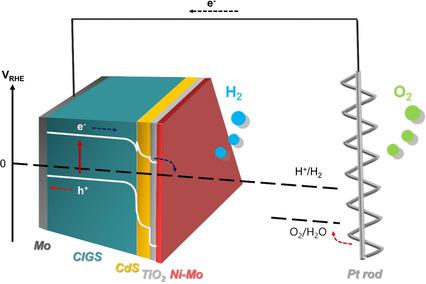当前位置:
X-MOL 学术
›
ChemSusChem
›
论文详情
Our official English website, www.x-mol.net, welcomes your feedback! (Note: you will need to create a separate account there.)
Enhancing Durability and Photoelectrochemical Performance of the Earth Abundant Ni–Mo/TiO2/CdS/CIGS Photocathode under Various pH Conditions
ChemSusChem ( IF 8.4 ) Pub Date : 2018-09-13 , DOI: 10.1002/cssc.201801211 Minki Baek 1 , Muhammad Zafar 2 , Seongbeen Kim 3 , Do‐Heyoung Kim 2 , Chan‐Wook Jeon 4 , Jinwoo Lee 3 , Kijung Yong 1
ChemSusChem ( IF 8.4 ) Pub Date : 2018-09-13 , DOI: 10.1002/cssc.201801211 Minki Baek 1 , Muhammad Zafar 2 , Seongbeen Kim 3 , Do‐Heyoung Kim 2 , Chan‐Wook Jeon 4 , Jinwoo Lee 3 , Kijung Yong 1
Affiliation

|
Cu(In,Ga)(S,Se)2 (CIGS) is a promising photocathode material owing to its high absorption coefficient, adjustable band gap, and suitable band edge for the hydrogen evolution reaction (HER). However, most CIGS photocathodes have suffered from instability in applications that require a wide range of pH conditions and have utilized noble metal HER catalysts to achieve a high performance. Thus, improving the durability of the CIGS photocathode under various pH conditions and developing a cost‐effective non‐noble metal catalyst are critical issues in the photoelectrochemical (PEC) application of this promising photocathode material. Here, we catalyze the CIGS photocathode with Ni–Mo as a non‐noble metal to enhance the PEC efficiency, and we employ atomically grown TiO2 to passivate the CdS/CIGS surface and improve the stability under a wide range of pH conditions. Our Ni–Mo alloy exhibits the best HER catalytic activity among reported earth‐abundant HER catalysts in both acidic and alkaline solutions. The Ni–Mo/CdS/CIGS photocathode yields an onset potential of 0.5 V (vs. RHE) and a short‐circuit photocurrent density as high as 15–25 mA cm−2 under various pH conditions ranging from 0.4 to 14, which is highly comparable to that of Pt/CdS/CIGS. Furthermore, the passivation of CdS/CIGS with a thin TiO2 layer, obtained by atomic layer deposition, effectively prevents the photocorrosion of CdS and the dissolution of the Mo back contact, which are the main causes of the degradation of the photocathode. The optimized Ni–Mo/TiO2/CdS/CIGS photocathode produces a stable photocurrent density at 0 VRHE for 100 minutes except under strong alkaline conditions. The current work presents a very useful method to improve the efficiency and durability of the CIGS photocathodes with an earth‐abundant metal catalyst, which completely replaces Pt.
中文翻译:

在各种pH条件下增强地球上大量的Ni-Mo / TiO2 / CdS / CIGS光电阴极的耐久性和光电化学性能
Cu(In,Ga)(S,Se)2(CIGS)由于其高吸收系数,可调节的带隙和适合氢析出反应(HER)的能带边缘而成为一种很有前景的光电阴极材料。但是,大多数CIGS光电阴极在要求宽范围pH条件的应用中存在不稳定性,并已利用贵金属HER催化剂来实现高性能。因此,在这种有前景的光阴极材料的光电化学(PEC)应用中,提高CIGS光电阴极在各种pH条件下的耐久性以及开发具有成本效益的非贵金属催化剂是关键问题。在这里,我们以Ni-Mo作为非贵金属催化CIGS光电阴极,以提高PEC效率,并采用原子生长的TiO 2钝化CdS / CIGS表面,并改善在各种pH条件下的稳定性。我们的镍钼合金在酸性和碱性溶液中均表现出在报道的富含地球的HER催化剂中最好的HER催化活性。Ni-Mo / CdS / CIGS光电阴极在0.4至14的各种pH条件下产生的起始电势为0.5 V(vs. RHE),短路光电流密度高达15–25 mA cm -2。与Pt / CdS / CIGS具有高度可比性。此外,通过原子层沉积获得的具有薄TiO 2层的CdS / CIGS钝化有效地防止了CdS的光腐蚀和Mo背接触的溶解,这是造成光电阴极退化的主要原因。优化的Ni-Mo / TiO 2/ CdS / CIGS光电阴极在强碱性条件下,在0 V RHE下持续100分钟产生稳定的光电流密度。当前的工作提出了一种非常有用的方法,可以使用富含稀土的金属催化剂来提高CIGS光电阴极的效率和耐久性,该催化剂可以完全替代Pt。
更新日期:2018-09-13
中文翻译:

在各种pH条件下增强地球上大量的Ni-Mo / TiO2 / CdS / CIGS光电阴极的耐久性和光电化学性能
Cu(In,Ga)(S,Se)2(CIGS)由于其高吸收系数,可调节的带隙和适合氢析出反应(HER)的能带边缘而成为一种很有前景的光电阴极材料。但是,大多数CIGS光电阴极在要求宽范围pH条件的应用中存在不稳定性,并已利用贵金属HER催化剂来实现高性能。因此,在这种有前景的光阴极材料的光电化学(PEC)应用中,提高CIGS光电阴极在各种pH条件下的耐久性以及开发具有成本效益的非贵金属催化剂是关键问题。在这里,我们以Ni-Mo作为非贵金属催化CIGS光电阴极,以提高PEC效率,并采用原子生长的TiO 2钝化CdS / CIGS表面,并改善在各种pH条件下的稳定性。我们的镍钼合金在酸性和碱性溶液中均表现出在报道的富含地球的HER催化剂中最好的HER催化活性。Ni-Mo / CdS / CIGS光电阴极在0.4至14的各种pH条件下产生的起始电势为0.5 V(vs. RHE),短路光电流密度高达15–25 mA cm -2。与Pt / CdS / CIGS具有高度可比性。此外,通过原子层沉积获得的具有薄TiO 2层的CdS / CIGS钝化有效地防止了CdS的光腐蚀和Mo背接触的溶解,这是造成光电阴极退化的主要原因。优化的Ni-Mo / TiO 2/ CdS / CIGS光电阴极在强碱性条件下,在0 V RHE下持续100分钟产生稳定的光电流密度。当前的工作提出了一种非常有用的方法,可以使用富含稀土的金属催化剂来提高CIGS光电阴极的效率和耐久性,该催化剂可以完全替代Pt。


























 京公网安备 11010802027423号
京公网安备 11010802027423号